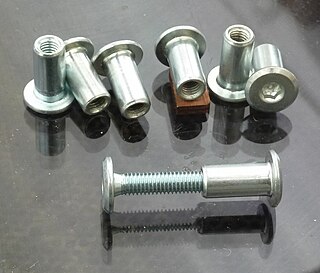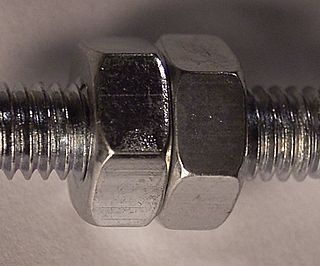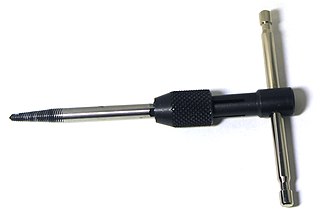
Bolted joints are one of the most common elements in construction and machine design. They consist of fasteners that capture and join other parts, and are secured with the mating of screw threads.

A taper pin is a fastener used in mechanical engineering. They are steel rods with one end having a slightly larger diameter than the other. Standard inch-sized taper pins have a taper on diameter of 1:48 while metric ones have a taper of 1:50. A 1:48 taper means that one end of a 4-foot-long bar (48 inches) will be 1 inch smaller in diameter than the other end, or a 1/4-inch taper over a 1-foot length.

A sex bolt,, is a type of fastener (nut) that has a barrel-shaped flange and protruding boss that is internally threaded. The boss sits within the components being fastened, the flange provides the bearing surface. The sex bolt and accompanying machine screw sit flush on either side of the surfaces being fastened. It is normally chosen because of its low profile compared to other nuts. The sex bolt often has a built-in feature, such as a slot, to aid in tightening the fastener. Some sex bolts, more commonly known as "architectural bolts", have knurled barrels to allow one-sided assembly. "Binding posts" are similar to architectural bolts in that they are designed to be assembled from one side, but they have teeth on the flanged surface to keep them fixed.

A nyloc nut, also referred to as a nylon-insert lock nut, polymer-insert lock nut, or elastic stop nut, is a kind of locknut with a nylon collar insert that resists turning.

A jam nut is a low profile type of nut, typically half as tall as a standard nut. It is commonly used as a type of locknut, where it is "jammed" up against a standard nut to lock the two in place. It is also used in situations where a standard nut would not fit.
A split beam nut, also known as a split hex nut or slotted beam nut, is a locknut with slots cut in the top that separate the outside end into two or more sections that are bent slightly inward, making the thread diameter undersized in the slotted portion. As the nut is threaded on, these sections are forced back out to their original position and increase the friction between the nut and the fastener, creating the locking action.
A speed nut, aka sheet metal nut or Tinnerman nut, is a type of locknut with two sheet metal prongs that act as one thread. They are made from spring steel.
A jet nut, also known as a k-nut, is a special type of hex locknut that is commonly used in the aerospace and automotive racing industries.
A plate nut, also known as a nut plate, anchor nut or anchor plate, is a stamped sheet metal nut that is usually riveted to a workpiece. They have a long tube that is internally threaded and a plate with two clearance holes for rivets. The most popular versions have two lugs and they exist as fixed anchor nuts and as floating anchor nuts. The latter allows the nut to move slightly and so enlarges the positioning tolerances of the mounted parts. They were originally developed for the aerospace industry, but are now also common in automotive racing. These nuts are made up of variety of soft and hard materials. The choice of material depends on environment to which nut is subjected. Soft materials like copper or brass are used when nut is used in electrical application. Hard materials are used when nut is subjected to high stress environment. Sometimes stainless steel or nickel-plated nuts are used in order to increase corrosion resistance.
ISO 898 is an international standard that defines mechanical and physical properties for metric fasteners. This standard is the origin for other standards that define properties for similar metric fasteners, such as SAE J1199 and ASTM F568M. It is divided into five (nonconsecutive) parts:

A screw extractor is a tool for removing broken or seized screws. There are two types: one has a spiral flute structure, commonly called an easy out after the trademarked name EZ-Out; the other has a straight flute structure. Screw extractors are intentionally made of hard, brittle steel, and, if too much torque is applied, can break off inside the screw that is being removed. Since the extractor is an extremely hard material, and a typical home shop drill bit will not be able to drill into it, a larger element of difficulty is added to the original screw extraction project. One way to avoid this added difficulty is to drill a hole completely through the screw. Thus, if the fastener breaks, a punch can be used to drive out the easy out from the screw, via the back, or end, of the fastener.

A bolt is a form of threaded fastener with an external male thread. Bolts are closely related to screws.
Philidas Ltd. is a company based in Pontefract, West Yorkshire, England that manufactures nuts and components for automotive and industrial applications.
A Palnut® Fastener is a variation of the lock nut device for bolts which are intended to fasten securely without welding or any other permanent fastening. The Palnut is a registered trademark of Tinnerman Palnut Engineered Products LLC. The device is screwed on the bolt on top of an underneath the nut, and has a series of protruding barbs that locks the nut in place when the nut is tightened then twisting the Palnut to lock the bolt in place. The Palnut itself is a reusable means of bolt stability. While there are some better means of permanent fastening methods. Palnut's are a good solution to low maintenance and fast means of securing two items together and ensuring that they stay together.

A security locknut is a type of industrial fastener composed of two steel threaded parts: a nut body and an elliptical spring steel lock ring. Security locknuts are fastened onto a mating bolt to form a bolted joint. Forces of friction, a stretching of the bolt, and compression hold the bolted joint firmly together. The lock ring, once assembled into a counterbore in the nut body, provides clamping force on the bolt while the nut body takes the load. This isolates the loading and locking functions and helps prevent the nut from backing off the bolt. Due to the durable spring steel alloy, the security locknut is fully reusable while maintaining prevailing torque in each application.









